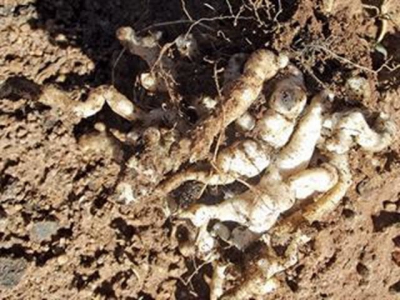Combating clubroot in cabbage

Clubroot is an extremely serious disease; if it gets into your lands, it can destroy the entire crop.
All cruciferous vegetables crops are susceptible, while a number of other crops including canola, red clover and perennial ryegrass, as well as weeds such as Polygonum, may serve as hosts without showing any obvious symptoms. The disease is caused by Plasmodiophora brassicae. For a long time, this was believed to be a fungus, but recent research has determined that this parasite can be placed in the Phytomyxea group.
Usually, clubroot first manifests as plants wilting in isolated patches on the land. This might not appear serious, but it can lead to complete crop failure the following year or season. The pathogen can survive in soil for up to 10 years without a host!
It is also spread easily via soil and mud on tractors, implements and workers’ shoes. Wet soil and warmth provide the most favourable conditions for its spread and development.
As its name indicates, clubroot enters the roots and causes them to swell and look like sausages. This impairs their proper functioning, and the plant will wilt even in moist soil. Growth then stops. I have also seen how a river used for irrigation
can spread the disease. All it takes is a heavy rainstorm to wash some soil into the river. In the example I saw, the pathogens flowed from the infected farm to many other farms downstream.
Various products are recommended for infected lands, but these are very expensive and, at best, can only reduce the damage; they are not a long-term solution.
The only answer to the problem
There is only one effective remedy: increase the pH of the soil to a level where crops can still be successfully grown, but which prevents P. brassicae from germinating. The water pH test of the soil sample should be at least 7,2 to 7,3. This is
higher than considered ideal for most crops, but it won’t hinder the performance of your cabbages. The reality is that if you have clubroot in your soil and wish to grow cruciferous crops, you have little choice but to adjust the soil pH.
I once knew a farmer who had two farms in the same district. He used the same workers and the same tractors to work both farms. The only effective difference in management was that one farm was irrigated from boreholes and the other from dams which collected runoff water. As borehole water in this district contains a fair amount of calcium, the soil pH is on the high side, whereas the dam water has very little calcium and the soil is more acidic. The dam water-irrigated farm had a clubroot problem, while the other farm was free from it, as were the other farms in the area.
A long process
The farmer first fumigated the ‘clubroot farm’ with metam sodium at great expense and little success. Then he resorted to increasing the soil pH by liming, which put an end to the problem. Bear in mind that it takes a while for the soil pH to stabilise after application and it can take a few years for the problem to be rectified. Use as fine a grade of lime as possible, worked well into the soil to hasten the process.
Hydrated lime is about 30 times more active (quicker) than normal agricultural lime, but it is expensive. As a costsaver, you can apply 1t/ ha hydrated lime and use agricultural lime for the balance.
Test the soil frequently
Soil pH tends to gradually decline over time, so you should carry out frequent soil tests to ensure that the pH is safe before planting cabbages again. Ask for the test that provides a ‘water pH’, not the KCL pH, as the latter will provide a misleading reading for your purposes.
Có thể bạn quan tâm
 How to Grow Banana Plants Indoors and Outdoor - Part 2
How to Grow Banana Plants Indoors and Outdoor - Part 2 There are banana varieties that can withstand temperature drops and grows well in pots or containers, popular especially among the fans of exotic tropical plant
 How to Grow Tomatoes
How to Grow Tomatoes Most tomatoes are what are technically known as ‘indeterminate’ in growth. Given a suitable climate, they will go on growing almost ad infinitum, throwing out
 Guide to Growing Cabbages
Guide to Growing Cabbages Cabbages can still be found growing wild in many Mediterranean regions as well as on the southern coastal areas of the British Isles. Intensive breeding